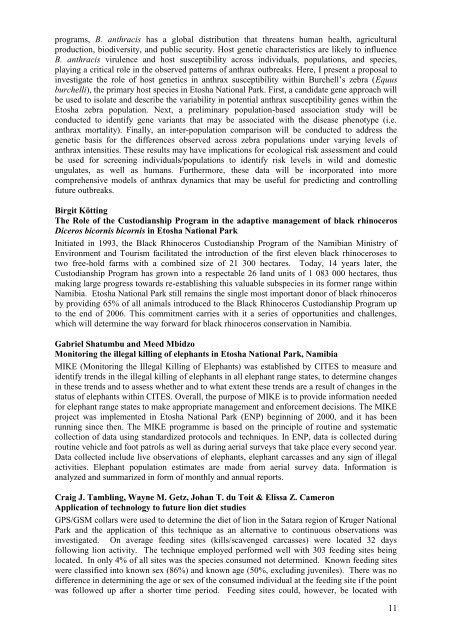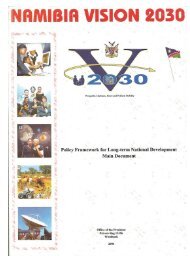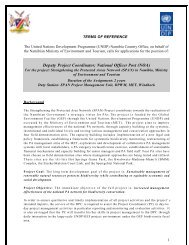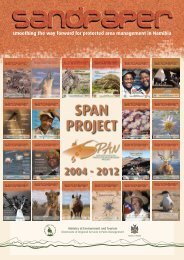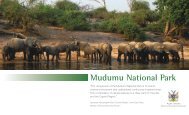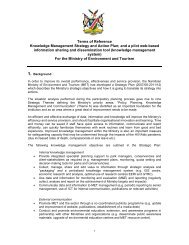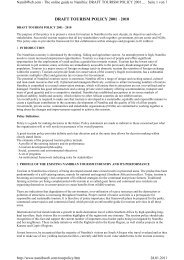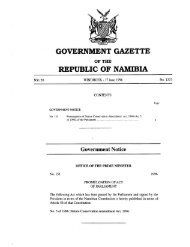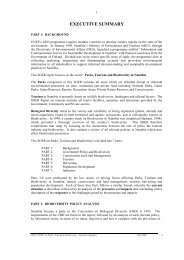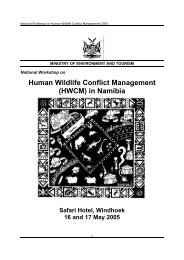Etosha: the Human Footprint - Ministry of Environment and Tourism
Etosha: the Human Footprint - Ministry of Environment and Tourism
Etosha: the Human Footprint - Ministry of Environment and Tourism
Create successful ePaper yourself
Turn your PDF publications into a flip-book with our unique Google optimized e-Paper software.
programs, B. anthracis has a global distribution that threatens human health, agricultural<br />
production, biodiversity, <strong>and</strong> public security. Host genetic characteristics are likely to influence<br />
B. anthracis virulence <strong>and</strong> host susceptibility across individuals, populations, <strong>and</strong> species,<br />
playing a critical role in <strong>the</strong> observed patterns <strong>of</strong> anthrax outbreaks. Here, I present a proposal to<br />
investigate <strong>the</strong> role <strong>of</strong> host genetics in anthrax susceptibility within Burchell‟s zebra (Equus<br />
burchelli), <strong>the</strong> primary host species in <strong>Etosha</strong> National Park. First, a c<strong>and</strong>idate gene approach will<br />
be used to isolate <strong>and</strong> describe <strong>the</strong> variability in potential anthrax susceptibility genes within <strong>the</strong><br />
<strong>Etosha</strong> zebra population. Next, a preliminary population-based association study will be<br />
conducted to identify gene variants that may be associated with <strong>the</strong> disease phenotype (i.e.<br />
anthrax mortality). Finally, an inter-population comparison will be conducted to address <strong>the</strong><br />
genetic basis for <strong>the</strong> differences observed across zebra populations under varying levels <strong>of</strong><br />
anthrax intensities. These results may have implications for ecological risk assessment <strong>and</strong> could<br />
be used for screening individuals/populations to identify risk levels in wild <strong>and</strong> domestic<br />
ungulates, as well as humans. Fur<strong>the</strong>rmore, <strong>the</strong>se data will be incorporated into more<br />
comprehensive models <strong>of</strong> anthrax dynamics that may be useful for predicting <strong>and</strong> controlling<br />
future outbreaks.<br />
Birgit Kötting<br />
The Role <strong>of</strong> <strong>the</strong> Custodianship Program in <strong>the</strong> adaptive management <strong>of</strong> black rhinoceros<br />
Diceros bicornis bicornis in <strong>Etosha</strong> National Park<br />
Initiated in 1993, <strong>the</strong> Black Rhinoceros Custodianship Program <strong>of</strong> <strong>the</strong> Namibian <strong>Ministry</strong> <strong>of</strong><br />
<strong>Environment</strong> <strong>and</strong> <strong>Tourism</strong> facilitated <strong>the</strong> introduction <strong>of</strong> <strong>the</strong> first eleven black rhinoceroses to<br />
two free-hold farms with a combined size <strong>of</strong> 21 300 hectares. Today, 14 years later, <strong>the</strong><br />
Custodianship Program has grown into a respectable 26 l<strong>and</strong> units <strong>of</strong> 1 083 000 hectares, thus<br />
making large progress towards re-establishing this valuable subspecies in its former range within<br />
Namibia. <strong>Etosha</strong> National Park still remains <strong>the</strong> single most important donor <strong>of</strong> black rhinoceros<br />
by providing 65% <strong>of</strong> all animals introduced to <strong>the</strong> Black Rhinoceros Custodianship Program up<br />
to <strong>the</strong> end <strong>of</strong> 2006. This commitment carries with it a series <strong>of</strong> opportunities <strong>and</strong> challenges,<br />
which will determine <strong>the</strong> way forward for black rhinoceros conservation in Namibia.<br />
Gabriel Shatumbu <strong>and</strong> Meed Mbidzo<br />
Monitoring <strong>the</strong> illegal killing <strong>of</strong> elephants in <strong>Etosha</strong> National Park, Namibia<br />
MIKE (Monitoring <strong>the</strong> Illegal Killing <strong>of</strong> Elephants) was established by CITES to measure <strong>and</strong><br />
identify trends in <strong>the</strong> illegal killing <strong>of</strong> elephants in all elephant range states, to determine changes<br />
in <strong>the</strong>se trends <strong>and</strong> to assess whe<strong>the</strong>r <strong>and</strong> to what extent <strong>the</strong>se trends are a result <strong>of</strong> changes in <strong>the</strong><br />
status <strong>of</strong> elephants within CITES. Overall, <strong>the</strong> purpose <strong>of</strong> MIKE is to provide information needed<br />
for elephant range states to make appropriate management <strong>and</strong> enforcement decisions. The MIKE<br />
project was implemented in <strong>Etosha</strong> National Park (ENP) beginning <strong>of</strong> 2000, <strong>and</strong> it has been<br />
running since <strong>the</strong>n. The MIKE programme is based on <strong>the</strong> principle <strong>of</strong> routine <strong>and</strong> systematic<br />
collection <strong>of</strong> data using st<strong>and</strong>ardized protocols <strong>and</strong> techniques. In ENP, data is collected during<br />
routine vehicle <strong>and</strong> foot patrols as well as during aerial surveys that take place every second year.<br />
Data collected include live observations <strong>of</strong> elephants, elephant carcasses <strong>and</strong> any sign <strong>of</strong> illegal<br />
activities. Elephant population estimates are made from aerial survey data. Information is<br />
analyzed <strong>and</strong> summarized in form <strong>of</strong> monthly <strong>and</strong> annual reports.<br />
Craig J. Tambling, Wayne M. Getz, Johan T. du Toit & Elissa Z. Cameron<br />
Application <strong>of</strong> technology to future lion diet studies<br />
GPS/GSM collars were used to determine <strong>the</strong> diet <strong>of</strong> lion in <strong>the</strong> Satara region <strong>of</strong> Kruger National<br />
Park <strong>and</strong> <strong>the</strong> application <strong>of</strong> this technique as an alternative to continuous observations was<br />
investigated. On average feeding sites (kills/scavenged carcasses) were located 32 days<br />
following lion activity. The technique employed performed well with 303 feeding sites being<br />
located. In only 4% <strong>of</strong> all sites was <strong>the</strong> species consumed not determined. Known feeding sites<br />
were classified into known sex (86%) <strong>and</strong> known age (50%, excluding juveniles). There was no<br />
difference in determining <strong>the</strong> age or sex <strong>of</strong> <strong>the</strong> consumed individual at <strong>the</strong> feeding site if <strong>the</strong> point<br />
was followed up after a shorter time period. Feeding sites could, however, be located with<br />
11


